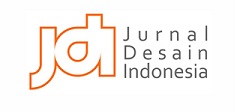PERANCANGAN TEKNIK SULAM KRUISTIK SEBAGAI HIASAN PADA KELAMBU TEMPAT TIDUR BAYI
Abstract
Currently the use of mosquito nets is mostly replaced by using mosquito repellents with modern electronic devices that are filled with liquid. However, excessive use of chemicals is very bad for the health of the body in long term. This is makes the author have the idea to design a baby mosquito net by add a cross stitch technique in creating a motif on the fabric surface design so that the mosquito net in addition to protecting it self from mosquito bites, the mosquito net can also be a decorative in the room because of the motifs made using cross stitch techniques. The design of mosquito net product is carried out using the application theory of SP. Gustami in creating craft art there are three stages, the exploration stage which includes the search for ideas and data for the initial design, the design stage includes data analysis as a reference in making the work, and the embodiment stage includes the final result of the work. The cross embroidery technique was chosen as a way to apply the motif, which has been considered from how the structure of the perforated tille fabric. The advantages of using the technique of cross embroidery, the resulting motif are more neat and orderly, the shapes and colors that are expected from the beginning of the design can be realized ad expected.
Keywords
Full Text:
PDF (Bahasa Indonesia)References
Adiputra, A. M. (2017). The Exploration Of Fish Shape in Creating Fine Art Work. Yogyakarta: UPT Perpustakaan ISI Yogyakarta.
Alami, R. (2016). Tindakan Pencegahan Malaria di Desa Sudorogo Kec. Kaligesing Kab. Purworejo. Jurnal Promeks. Vol.4 No. 2, 199-221.
Apriyanto, L. (2018). Ragam Hias Majapahit dalam Karya Perhiasan. Yogyakarta: UPT Perpustakaan ISI Yogyakarta.
Cahyani, D., & Nelmira, D. (2019). Kerajinan Sulaman Kruistik di Nagari Embunpagi Kec. Matur Kab. Agam Subar. Gorga: Jurnal Seni Rupa, Vol.8(1), 243-247.
Ernawati. (2008). Tata Busana. Jakarta: Departemen Pendidikan Nasional.
Gustami, SP. (2007). Butir-Butir Mutiara Estetika Timur: Ide Dasar Seni Kriya Indonesia. Yogyakarta: Prasista.
Mokalu, W. A. Y., Umboh, J. M. L., & Sondakh, R. C. (2017). Gambaran Penggunaan Bahan Anti Nyamuk, Pemakaian Kelambu, Kawat Kasa, dan Tempat Perindukan Nyamuk di Wilayah Kerja Puskesmas Motoboi Kecil Kota Kotamobagu. KESMAS, Vol. 6(3).
Ningsih, S. S., Ernis, & Jupriani. (2017). Studi Tentang Bentuk Motif dan Teknik Sulaman Baju di Desa Nareh Kota Pariaman. SERUPA: The Journal of Art Education, Vol.5(2), 1-13.
Pratiwi, D. I., & Hargono, R. (2017). Analisis Tindakan Warga Desa Payaman Dalam Mencegah Penyakit DBD. Jurnal Promeks, Vol 5(2), 181-192.
Prastiwi, E. P. (2015). “Pengaruh Penggunaan Obat Nyamuk Coil dan Mat Elektrik Terhadap Sel Darah Mencit(Mus musculus, L.)”. [Skripsi]. Surakarta: FKIP, Pendidikan Biologi, Universitas Muhammadiyah Surakarta.
Sri Ambarwati, D. R. (2017). Antara Desainer Interior dan Dekorator Interior: Studi Perbandingan. Yogyakarta: Fakultas Bahasa dan Seni FBS UNY.
Prihatini, P. T., & Suciati. (2017). Macam-Macam Tusuk Hias Dasar. Prodi Pendidikan Tata Busana JPKK UPI.
Sulam, A. L. (2008). Teknik Pembuatan Benang dan Pembuatan Kain. Jakarta: Departemen Pendidikan Nasional.
Sulistiyani, C. (2012). Beberapa Faktor yang Berhubungan dengan Kualitas Tidur pada Mahasiswa. Jurnal Kesehatan Masyarakat Universitas Diponegoro, Vol.1(2), 280-292.
DOI: http://dx.doi.org/10.22441/narada.2022.v9.i1.005
Refbacks
- There are currently no refbacks.
Fakultas Desain dan Seni Kreatif
Universitas Mercu Buana
Gedung E Lantai 4
Jl. Raya Meruya Selatan no.1, Kembangan, Jakarta 11650
Tlp./Fax: +62215871335
Journal International Standard Serial Number (ISSN) Registration:
The Journal is indexed by:
Tools for Citations & Plagiarism Detection:

Ciptaan disebarluaskan di bawah Lisensi Creative Commons Atribusi-NonKomersial 4.0 Internasional
 NARADA: Jurnal Desain dan Seni
NARADA: Jurnal Desain dan Seni

























